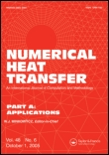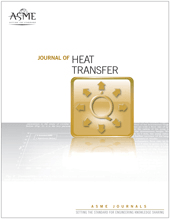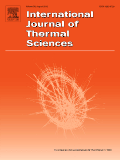
JOURNAL OF ENHANCED HEAT TRANSFER
Scope & Guideline
Pioneering Insights in Heat Transfer Technology
Introduction
Aims and Scopes
- Heat Transfer Enhancement Techniques:
The journal emphasizes innovative methods for enhancing heat transfer, including novel surface modifications, nanofluids, and advanced materials. Research often explores the mechanisms behind these enhancements and their applications in engineering. - Thermal Management in Energy Systems:
Research in this area focuses on optimizing heat transfer in energy systems, including thermal energy storage, solar thermal applications, and waste heat recovery. The goal is to improve efficiency and sustainability in energy conversion processes. - Numerical and Experimental Investigations:
The journal features a substantial amount of work involving both numerical simulations and experimental studies. This dual approach enables comprehensive validation of models and techniques, fostering a deeper understanding of heat transfer phenomena. - Multiphase and Non-Newtonian Fluid Dynamics:
There is a consistent focus on the behavior of multiphase flows and non-Newtonian fluids in heat transfer applications. This includes studies on boiling, condensation, and the use of advanced fluids such as nanofluids and phase change materials. - Heat Exchangers and Heat Sink Design:
Research on the design and optimization of heat exchangers and heat sinks is prevalent. The journal publishes studies that explore various configurations, geometries, and materials to enhance thermal performance.
Trending and Emerging
- Nanofluids and Hybrid Materials:
Research on nanofluids and hybrid materials is gaining traction, focusing on their enhanced thermal properties and applications in various heat transfer systems, including cooling technologies and energy storage. - Machine Learning Applications in Heat Transfer:
There is an increasing trend towards integrating machine learning and artificial intelligence methodologies with heat transfer research. This includes optimizing heat exchanger designs and predicting thermal performance based on complex datasets. - Sustainable and Renewable Energy Solutions:
Emerging themes include the exploration of sustainable energy solutions, particularly in solar thermal systems and energy-efficient technologies, reflecting a global push towards sustainability and reduced carbon footprints. - Advanced Micro and Nano-structured Surfaces:
Research is increasingly focusing on the development and testing of micro and nano-structured surfaces to enhance heat transfer performance in various applications, including electronics cooling and thermal management. - Thermal Energy Storage Innovations:
Innovative approaches to thermal energy storage, particularly using phase change materials and advanced thermal management strategies, are becoming more prominent, driven by the need for efficient energy use and sustainability.
Declining or Waning
- Traditional Heat Transfer Materials:
There is a noticeable decrease in research focused solely on traditional materials for heat transfer applications, such as copper and aluminum, with more emphasis shifting towards advanced materials like nanofluids and hybrid composites. - Basic Heat Transfer Theory:
Papers that primarily address fundamental heat transfer theory without application to modern technologies or materials are becoming less common, as researchers increasingly favor studies with practical implications and innovative applications. - Conventional Cooling Techniques:
Studies focused on conventional cooling techniques, such as air cooling without enhancements or modifications, are appearing less frequently as the field moves towards more complex and efficient cooling strategies. - Single-phase Fluid Studies:
Research solely concentrating on single-phase fluid heat transfer is declining, with a greater focus now on multiphase systems and their interactions, which are seen as more relevant to current engineering challenges.
Similar Journals

Journal of Engineering Thermophysics
Advancing thermal science for innovative engineering solutions.Journal of Engineering Thermophysics, published by PLEIADES PUBLISHING INC, is a premier academic journal dedicated to advancing the field of thermophysics and its applications across a variety of engineering disciplines. With an ISSN of 1810-2328 and an E-ISSN of 1990-5432, this journal offers an essential platform for researchers and professionals to disseminate cutting-edge findings on the interplay between thermal processes and engineering systems. As of 2023, it is recognized within the Q3 category in key fields such as Condensed Matter Physics, Energy Engineering and Power Technology, Environmental Engineering, and Modeling and Simulation. Moreover, the journal contributes to an important dialogue in the environmental sciences, ranking 111 out of 197 in Environmental Engineering, and positions itself prominently within the academic landscape from its establishment in 2007. Although currently not an open-access journal, it facilitates a selective yet impactful communication of research that drives innovation and knowledge in the thermal sciences. For those engaged in understanding the thermal dynamics essential for sustainable engineering solutions, the Journal of Engineering Thermophysics is the go-to resource for published research, reviews, and advancements in the field.

NUMERICAL HEAT TRANSFER PART A-APPLICATIONS
Exploring innovative applications in condensed matter physics.NUMERICAL HEAT TRANSFER PART A-APPLICATIONS, published by TAYLOR & FRANCIS INC, serves as a premier outlet for cutting-edge research in the domains of numerical analysis and condensed matter physics. With an ISSN of 1040-7782 and an E-ISSN of 1521-0634, this esteemed journal has steadily maintained its influence in the academic community since its establishment in 1989, continuing its publication into 2024. Currently ranked in the Q2 quartile for both Condensed Matter Physics and Numerical Analysis, it stands as a vital resource for researchers committed to advancing computational methodologies and applications. The journal's Scopus rankings reflect its growing impact, particularly in mathematics, where it is placed in the top 26% of its category. Although not an open-access journal, its comprehensive research articles and detailed applications foster innovation and collaboration, making it essential for professionals and students aiming to deepen their understanding of thermal transfer phenomena through numerical techniques. This journal not only bridges theory and application but also propels forward the field of heat transfer.

JOURNAL OF HEAT TRANSFER-TRANSACTIONS OF THE ASME
Connecting Researchers to the Heart of Heat Transfer.JOURNAL OF HEAT TRANSFER-TRANSACTIONS OF THE ASME, with ISSN 0022-1481 and E-ISSN 1528-8943, is a leading publication in the field of heat transfer, mechanical engineering, and related disciplines, published by the renowned American Society of Mechanical Engineers (ASME). This esteemed journal, which has been in circulation since 1945, provides a platform for novel research findings and reviews that the mechanical engineering community can rely upon, contributing significantly to the advancement of knowledge in heat transfer processes. The journal is recognized for maintaining a strong impact in several categories, attaining Q2 quartile rankings in Condensed Matter Physics, Mechanical Engineering, and Mechanics of Materials, reflecting its influential role in shaping scientific dialogues. With a commendable Scopus ranking, including a percentile of 63rd in Mechanical Engineering, it attracts submissions from leading researchers and industry professionals alike. Although access options are currently undergoing changes, the commitment to disseminating cutting-edge research remains steadfast. Gathering insights from historical and contemporary studies, the JOURNAL OF HEAT TRANSFER stands as a vital resource for those aiming to innovate in heat transfer technologies and methodologies.

ASME Journal of Heat and Mass Transfer
Bridging Theory and Application in Heat TransferASME Journal of Heat and Mass Transfer, published by the renowned American Society of Mechanical Engineers (ASME), is a pivotal journal in the fields of mechanical engineering and materials science. With its ISSN 2832-8450 and E-ISSN 2832-8469, this journal aims to disseminate high-quality research focused on the principles and applications of heat transfer and mass transfer phenomena. Despite its recent launch, having converged from 2023 to 2024, it has quickly established a significant presence in the academic community, holding respectable rankings within the Scopus database across various categories—including a 66th percentile rank in Mechanical Engineering. The journal endeavors to foster innovation and collaborative research that advance the frontiers of knowledge in thermal sciences, making it an essential resource for researchers, practitioners, and students keen on exploring the challenges and developments in heat and mass transfer technologies. The journal also embraces an open-access model, ensuring that leading research reaches a broader audience and contributes to global knowledge sharing.

INTERNATIONAL JOURNAL OF THERMAL SCIENCES
Driving excellence in thermal research and applications.The INTERNATIONAL JOURNAL OF THERMAL SCIENCES is a premier academic journal published by ELSEVIER FRANCE-EDITIONS SCIENTIFIQUES MEDICALES ELSEVIER, focusing on cutting-edge research in the field of thermal sciences. With its ISSN 1290-0729 and E-ISSN 1778-4166, this journal has established itself as a crucial resource for scholars and professionals interested in the thermodynamic principles governing engineering and condensed matter physics. The journal is ranked Q1 in both Condensed Matter Physics and Engineering (miscellaneous), highlighting its exceptional quality and influence, as reflected in its impressive Scopus ranks: #32 out of 307 in General Engineering (89th percentile) and #57 out of 434 in Condensed Matter Physics (86th percentile). Researchers and students alike can benefit from the wealth of articles available, with access options designed to foster a wider dissemination of knowledge within the scientific community. Established in 1973 and ongoing through 2025, the journal invites contributions that advance the understanding of thermal phenomena and their applications, solidifying its importance in driving innovation and insight within these dynamic fields.

Journal of Thermal Science
Transforming thermal science into practical solutions.Journal of Thermal Science is a prestigious academic publication dedicated to the field of thermal science and its applications. Published by SPRINGER, this journal has been at the forefront of knowledge dissemination since its inception in 1992 and continues to provide a platform for researchers and professionals to share their innovative findings through high-quality peer-reviewed articles. With its ISSN 1003-2169 and E-ISSN 1993-033X, the journal covers a diverse array of topics related to thermal processes, materials, and engineering, significantly contributing to advancements in Condensed Matter Physics. In the latest rankings, it holds a commendable Q2 category in the 2023 quartiles, further highlighting its relevance with a Scopus ranking of #183/434 in its field, placing it in the top 57th percentile. While currently not offering open access, the journal strives to bridge the gap between theory and practice, making substantial impacts on both academia and industry. Its continued exploration of cutting-edge research ensures that it remains a key resource for students and professionals looking to expand their knowledge and foster innovation in thermal sciences.

ISI Bilimi ve Teknigi Dergisi-Journal of Thermal Science and Technology
Unveiling Breakthroughs in Thermal MethodologiesISI Bilimi ve Teknigi Dergisi-Journal of Thermal Science and Technology, published by the Turkish Society of Thermal Sciences and Technology, serves as a pivotal platform for disseminating cutting-edge research in the fields of thermal science, engineering, and materials science. With an ISSN of 1300-3615, this journal not only addresses critical advancements from 2008 to 2013 and 2015 to 2023, but also operates under the auspices of rigorous peer review, contributing to its reputable standing in academia. As a Q4 ranked journal in various disciplines including Atomic and Molecular Physics, Engineering, and Materials Science, it offers researchers and professionals essential insights, though it does not currently operate under an open access model. Situated in Ankara, Turkey, this journal is key to fostering collaboration and innovation among scholars, making it an indispensable resource for students and professionals eager to engage with the latest thermal science methodologies and technologies.

Transactions of the Korean Society of Mechanical Engineers B
Fostering collaboration and knowledge in mechanical systems.Welcome to the Transactions of the Korean Society of Mechanical Engineers B, a pivotal journal dedicated to advancing the field of mechanical engineering. Published by the esteemed Korean Society of Mechanical Engineers, this journal serves as a platform for the dissemination of innovative research and practical applications in mechanical engineering and related disciplines. With a focus on fostering knowledge exchange and collaboration, the journal publishes original research articles, reviews, and technical notes that contribute to the understanding and evolution of mechanical systems and technologies. The Transactions of the Korean Society of Mechanical Engineers B, which has been in circulation since 2007 and spans through 2024, is categorized within the Q4 quartile of mechanical engineering rankings and is indexed by Scopus, making it a valuable resource for researchers and professionals aiming to stay abreast of the latest developments in the field. Although it is not open access, its rigorous peer-review process ensures the integrity and quality of the published work, making it essential reading for academics and practitioners alike.

Frontiers in Heat and Mass Transfer
Unveiling New Horizons in Transport PhenomenaFrontiers in Heat and Mass Transfer is a premier open-access journal published by TECH SCIENCE PRESS that focuses on the interdisciplinary field of heat and mass transfer. Established in 2010, this journal has been pivotal in disseminating high-quality research aimed at advancing the understanding of energy and material transport phenomena. With an impressive commitment to open access, it ensures that all published articles are readily available to researchers, practitioners, and students globally, promoting knowledge sharing and collaboration. The journal currently holds a Q3 ranking in key categories such as Engineering, Materials Science, and Physics and Astronomy, as well as notable positioning in Scopus rankings. With a forward-looking scope extending from 2010 to 2024, Frontiers in Heat and Mass Transfer continues to be an essential platform for innovative research, fostering the development of practical applications across various scientific and engineering domains. We invite you to explore the latest contributions to this evolving field and consider this journal as a vital resource for your academic and professional growth.

APPLIED THERMAL ENGINEERING
Advancing thermal innovation for a sustainable future.Applied Thermal Engineering is a leading international journal dedicated to the field of thermal engineering, published by Pergamon-Elsevier Science Ltd. With an impressive impact factor indicating its significance in the academic community, this journal focuses on innovative research and developments related to energy engineering, fluid flow, and transfer processes, as well as manufacturing and mechanical engineering. Being indexed in top quartiles (Q1) across multiple categories, it ranks exceptionally well on platforms like Scopus, ensuring that contributors reach a wide and relevant audience. The journal supports both open access and subscription options, promoting the dissemination of vital research findings from 1996 to 2024. With its commitment to advancing the discipline and implementing rigorous peer-review processes, Applied Thermal Engineering serves as an essential resource for researchers, industry professionals, and students aiming to stay abreast of the latest advancements and applied methodologies in thermal science.